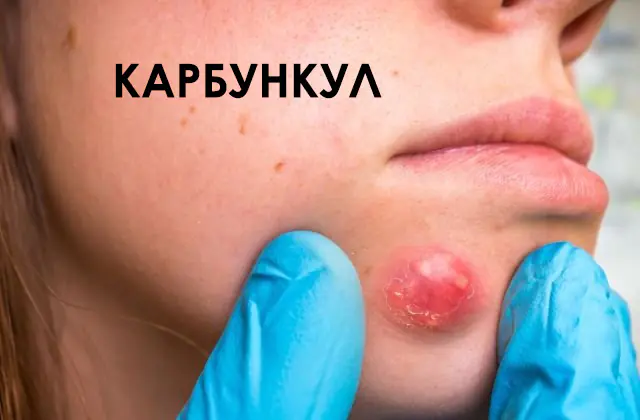
What is a carbuncle and how is it different from a boil? Causes and symptoms of the disease, how the diagnosis is made. Treatment of an abscess: medications, surgery for carbuncle. Prevention of disease.
The content of the article:- What is a carbuncle
- Causes
- Developmental symptoms
- Diagnostics
- Treatment options
- Medicines
- Surgical intervention
- Prevention
Carbuncle is a dangerous purulent-necrotic skin disease. Many people have heard the word “furuncle” - unpleasant inflammation of the hair follicles is familiar to 8 out of 10 people. The manifestations of the two pathologies are similar, so many people confuse the skin condition of a carbuncle with a boil. But it is important to understand that only a doctor can carry out a full diagnosis. It is difficult for a non-specialist to understand the difference between a boil and a carbuncle, and accordingly begin the correct treatment. If you suspect dermatological dysfunction, you should consult a doctor and immediately begin the recommended therapy.
What is a carbuncle?
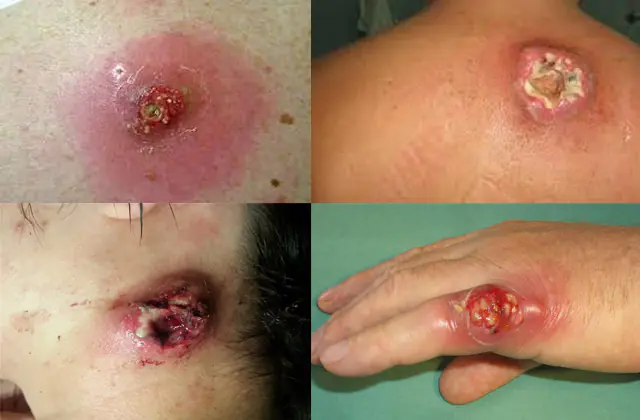
In the photo there is a carbuncle on the finger, neck and back
A disease called uglevik, boil, has been known for a long time. The purulent-inflammatory disease received its medical designation from the Latin word “Carbunculus”, which means coal. The analogy in this case is simple: the black color of necrotic tissue is associated with burnt coal.
In the international classification of diseases and health-related problems, pathology belongs to group L “Diseases of the skin and subcutaneous tissue”, subgroup 02 “Skin abscess, boil and carbunculus”, which are provoked by infections. Most often, the surgeon's patients are young men; the disease occurs in them 1.5 times more often than in women of the same age, although the pathology can develop in children, young and old. Autopsy of the carbuncle is most often performed in the summer. 40% of exacerbations occur during this period of time.
So what is Carbunculus, is it always necessary to treat it, and what are the dangers of complications? The pathogenesis of the disease is the same as that of a boil, but the affected area is much wider. The inflammatory process, affecting not one, as with a boil, but several hair follicles, provokes the accumulation of infiltrate in the skin and subcutaneous areas. As a rule, such inflammations are rare, but the disease occurs in an acute form.
As infiltration accumulates in the thickness of the skin, the blood supply to the affected area deteriorates. If treatment or removal of the carbuncle is not carried out on time, due to insufficient nutrition, certain areas of the skin begin to necrotize. Merging, the necrotizing parts form a single focus of necrosis, which continues to spread not only in the thickness of the skin, but also deeper - to the connective membrane and muscle fibers.
Many surgeons know what a mature carbuncle looks like, since without specialized surgical procedures the later stages of the disease do not go away on their own. On the contrary, the situation worsens: suppuration begins around the focus of necrosis, and dead cells undergo partial melting. As a result of rejection, pus begins to come out through multiple skin openings. After complete rejection of the purulent masses, the wound will be covered with young connective tissue, but given the extensive area of the lesion, the formation of a scar is inevitable. Timely treatment of the carbuncle will avoid irreparable consequences, such as large scars on the skin or abscesses.
Depending on the location, ulcers most often appear on the neck, back (especially between the shoulder blades) and buttocks, but cases of inflammation on the extremities cannot be excluded. If a carbuncle appears on the face, urgent treatment is necessary.
There are also special forms of the disease:
- anthrax ember - the pathology is caused by a special form of anthrax;
- purulent-necrotic kidney damage;
- emphysematous ember - the disease occurs rapidly in cattle and leads to the death of the animal.
Causes of carbuncle
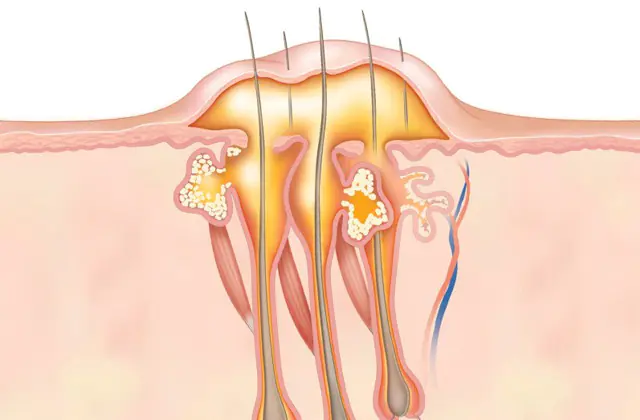
The most common cause of carbuncle is the activation of staphylococcus or streptococcal infection in the body. Specific forms of the disease can also be initiated by Escherichia coli, a special form of anthrax, enterococci and other pathogens. Three types of cocci are most often found on the human body - Staphylococcus aureus, epidermidis and saprophytic Staphylococcus. Pathogens are gram-positive, non-motile and begin their impact only when associated negative factors influence the body.
Most often, a carbuncle, the opening of which is mandatory, occurs when Staphylococcus aureus initiates. The pathogen enters the body through microtraumas, but begins a pathogenic effect for the following reasons:
- insufficient personal hygiene (especially during hot periods, which explains the peak of the disease in the summer);
- decreased immunity under the influence of various factors (hypothermia, frequent skin injuries, chronic diseases);
- increased sweating;
- improper or insufficient nutrition, vitamin deficiency;
- dysfunction of the excretory and endocrine systems (renal dysfunction, liver dysfunction, diabetes mellitus).
There have also been cases where the development of an abscess followed by removal of the carbuncle was provoked by long-term depressive states. But options cannot be ruled out when the first inflammations appear at the site of an insect bite or a squeezed pimple.
Note! The key factors in the development of ulcers are skin damage and poor hygiene, but the disease develops only under the influence of a complex of reasons. Identifying all provocateurs and stopping their effect on the body allows you to avoid relapses.Symptoms of carbuncle development
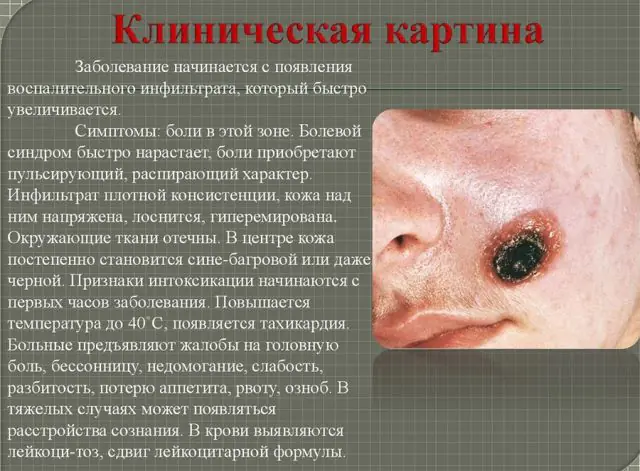
The symptoms of the pathology depend on the stage of the carbuncle. At the embryonic stage, several nodules with infiltrate form under the patient’s skin. Over time, they merge into one spherical formation. The size of the pustule in some cases reaches several centimeters in diameter. The first stage of the carbuncle lasts 7-12 days and ends with the appearance of purple-blue veins in the center of a spherical formation.
Characteristic symptoms of a carbuncle at the infiltration stage are also:
- severe itching at the site of several inflamed pustules, and as they unite, pain;
- inflammation and swelling of tissues near the formation;
- redness and bluish discoloration of healthy skin.
If a person develops anthrax carbuncle, the symptoms of the pathology at the infiltration stage will be slightly different. Firstly, the number of formations is not single (which is typical for the staphylococcal form of the disease). Secondly, mainly exposed areas of the skin (hands, face) are affected. The growth of the formation begins with a small red spot, which quickly develops, opening into an ulcer. Tissue necrosis begins in the center of the wound, and healthy areas of tissue along the edges become inflamed. Painful sensations in the ulcer are accompanied by a burning sensation. This form of the disease is also accompanied by inflammation of the lymph nodes, which, however, in addition to increased size, do not give other symptoms (without pain and pus).
The second stage of the disease is called purulent. It is characterized by increased formation of pus and expansion of the area of necrotizing tissue. It is quite difficult for an unprepared person to bear what a carbuncle looks like at this stage. Already from the 12th day, pustules (white pimples) form in the spherical infiltration body, sometimes resembling a plug. The release of these “plugs” is accompanied by the flow of pus, blood and rejection of necrotizing tissue. An open ulcer looks like a sieve with a gray bottom and loose edges. The entire surface, if the carbuncle is not treated on time, will turn black, and the necrotization processes will go deeper, in some cases affecting the muscles and reaching the bone tissue. The second stage lasts no more than 20 days. After which the ulcer is covered with granulation tissue.
A concomitant symptom of inflammatory processes in the body is also an increase in temperature to a dangerous 40, signs of intoxication of the body appear (including nausea and vomiting). Such symptoms are especially pronounced with a carbuncle on the face. If measures are not taken in time, meningitis will develop.
The pathology must be treated, since if the obvious symptoms of the disease are ignored, complications develop. The most critical complications of carbuncle are thrombophlebitis, sepsis, and lymphadenitis. When the abscess is localized in the nasal area, severe meningitis is inevitable. In advanced states of the disease or with severe physical exhaustion of the patient, death is possible. The malignant course of the disease is more common in elderly patients or those who, for one reason or another, neglect official methods of therapy.
Diagnosis of carbuncle
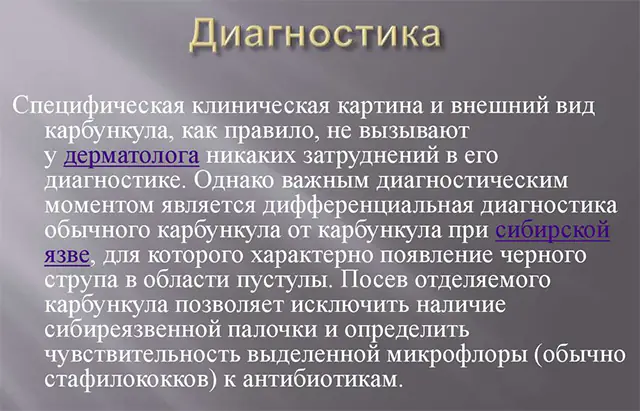
In order to make an accurate diagnosis, the dermatologist performs a visual examination of the lesion. Already based on external signs and location, preliminary conclusions can be drawn. Taking into account the specificity of the anthrax form of pathology, differential diagnosis will be carried out to exclude the manifestation of an epidemiologically dangerous disease. In this case, a general blood test and a smear of the composition from the pustule must be taken. Based on the results of bacterioscopic examination, the presence of anthrax is confirmed or excluded.
If a closed carbuncle is found on the body, the opening operation and further examination should only take place in a specialist’s office. In this case, an analysis of the fluid from the formation or an ultrasound scan of the inflamed area is also performed.
At later stages, a characteristic distinguishing feature of this disease from other ulcerative dysfunctions is the “lattice” structure, while in other pathologies there is usually only one outlet for pus to come out. Differentiation in diagnosis becomes easier.
Sowing material during the diagnosis of pathology allows not only to exclude anthrax, but also to examine the microflora for sensitivity to various drugs, and, accordingly, to select effective antibiotics for carbuncle.
Important! The pathology, as a rule, is isolated, but the doctor must conduct a full examination of the patient to detect possible recurrent foci of the disease.Methods for treating carbuncle
Therapy for purulent-necrotic inflammation should be carried out in a hospital setting, only in the early stages treatment at home is allowed, taking into account strict adherence to all doctor’s recommendations. Small formations on the extremities are subject to outpatient treatment in the absence of symptoms of intoxication of the patient.
Medicines for the treatment of carbuncle
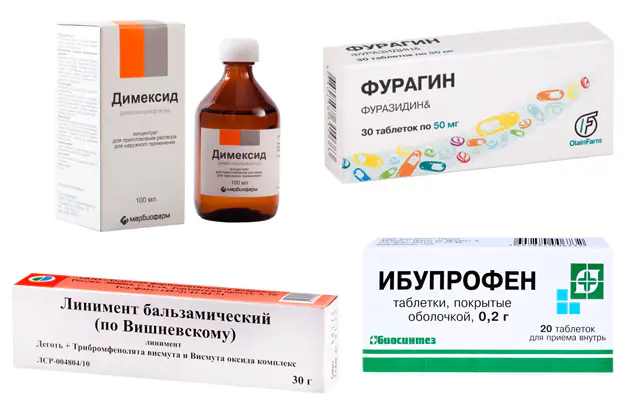
At the stage of infiltration, the patient is prescribed a general medical course of a conservative nature:
- Treatment of the abscess with ethyl alcohol 70%, dimexide solution or chlorhexidine, followed by application of an aseptic dressing. Antiseptics will cost from 16 to 22 hryvnia and from 34 to 59 rubles.
- It is allowed to use ointments for carbuncle (Vishnevsky or syntomycin). A tube of Vishnevsky's ointment will cost 12 hryvnia, 49 rubles, the product is used until the abscess is completely ripe. But at the healing stage, ointments are replaced; in this case, Levomekol (costs only 19 hryvnia, 123 rubles) or its analogues - Methyluracil (13 hryvnia, 117 rubles), Baneocin (107 hryvnia, 375 rubles) are better suited.
- Expansion of the inflammation zone will require the introduction of antibiotics into the therapeutic course, which are selected based on culture results.
- For oral administration, antibacterial (Furagin, Biseptol), anti-inflammatory (Ibuprofen or its analogues Arofen, Nurosan, Faspik), painkillers (No-shpa) are prescribed. Depending on the complex selected by the doctor, treatment can cost from 50 to several hundred hryvnia (200 rubles and more) in total for several medications.
An integrated approach to conservative therapy is aimed at suppressing the development of the purulent-necrotic process and maintaining the protective functions of the body. If such therapy began at the stage of maturation of the abscess, the likelihood of spontaneous resorption and tissue restoration is much higher.
However, if such treatment does not produce results, in addition to pricking the carbuncle with antibiotics, ultraviolet irradiation procedures are additionally prescribed, as well as drugs that prevent thrombus formation - Trental, Pentosyphylline. Such drugs must be taken strictly following the dosage recommended by the doctor; if necessary, you should consult a cardiologist before starting use. One package of Trental costs 225 hryvnia in Ukraine, 495 rubles in Russia.
In addition, the doctor prescribes medications that help eliminate toxins formed from the active activity of staphylococci in the body, for example, Zorex will cost 330 hryvnia, 467 rubles. Despite the fact that Zorex is available without a prescription, taking the drug without a doctor's recommendation is prohibited.
Improvement with conservative therapy will occur within 2-3 days, but it will take several weeks until complete recovery.
How to treat a carbuncle, in addition to the general health of the patient and the degree of inflammatory processes, also depends on the location. So, any ulcers on the face must be treated in a hospital setting. The patient is forbidden to even chew, much less talk or show facial expressions; food is offered in liquid form.
Surgical intervention for carbuncle
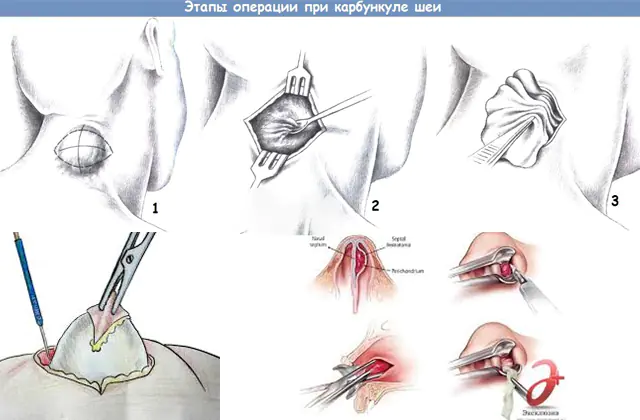
The photo shows the stages of surgery for neck carbuncle
Surgery for carbuncle is indicated if the formation greatly increases in size, hurts, the amount of infiltrate first decreased and then increased again, tissue necrosis has begun, or there are clear signs of intoxication of the body (high temperature).
The operation is carried out in the following sequence:
- sanitization of the area, hair removal if necessary;
- local anesthesia with novocaine solution;
- a cross-shaped incision is made over the focus of pathology; the depth of the incision should reach living tissue;
- pus and necrotic tissue are removed from the wound;
- sanitization is carried out with sodium chloride solution;
- the wound surface is covered.
The dressings on the wound are changed every day until the tissue is completely restored and young skin forms on top. Antibiotics continue until the wound heals. After a successful operation, scarring of the tissue will begin within a week, maximum 10 days.
Small purulent operations in Russia will cost up to 3,000 rubles, excluding the cost of preliminary consultations and anesthesia. In Ukraine, the price of the operation starts from 900 hryvnia. If removal is carried out using laser technology, the price reaches 6,000 rubles, 2,200 hryvnia in Russia and Ukraine, respectively.
The procedure can be repeated if there is a suspicion of further development of necrosis.
Important! Opening an abscess on your own is strictly prohibited. Such actions can lead to a deepening of the infection and the development of complications, including the death of the patient.Prevention of carbuncle
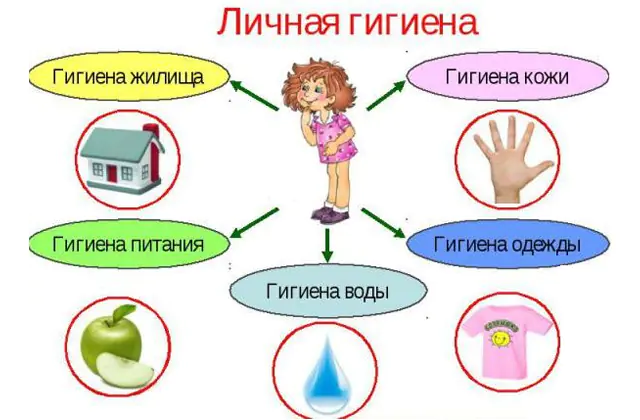
Treatment of purulent inflammation requires significant effort. It’s easier to prevent carbuncle. The main measures are aimed at eliminating or minimizing the impact of disease provoking factors.
To prevent carbuncle you need:
- observe personal hygiene measures, monitor the cleanliness of clothes and linen;
- avoid abrasions and damage to the skin (wear underwear, clothes and shoes that fit correctly);
- normalize eating habits - minimize sugar consumption, increase healthy foods in the diet, give up fatty and salty foods;
- on the recommendation of a doctor, supplement your daily medication intake with vitamin complexes;
- maintain immunity (moderate physical activity, adherence to a rest regime, avoid stress), and in case of diseases of various etiologies, treat them correctly.
Compliance with all preventive measures does not provide a full guarantee of safety, but still significantly reduces the risk of developing large formations. And increased attention to the patient’s own health will ensure timely diagnosis.
Carbuncle is a very unpleasant disease, signaling not only inflammatory processes in the body, but also a general weakening of the human immune system, exposure to a number of unfavorable factors, and insufficient hygiene. It is important for those who are ill to know the difference between a boil and a carbuncle, and under no circumstances make independent attempts to get rid of the problem. With proper therapy, the prognosis for recovery is quite favorable. A medical facility will help you completely get rid of the abscess and also eliminate the factors that provoked the disease. Complications of carbuncle in severe diabetes or thrombophlebitis are much more difficult to treat and can even cause the death of the patient. It is strongly recommended to follow disease prevention measures, and at the first symptoms of an abscess developing, consult a doctor.
Video about what a carbuncle is and how to treat it at home and in the hospital:



